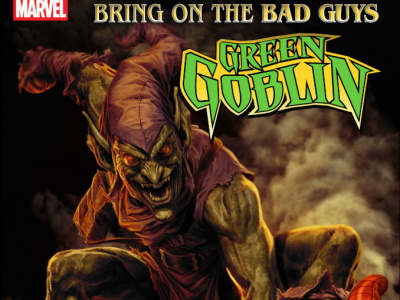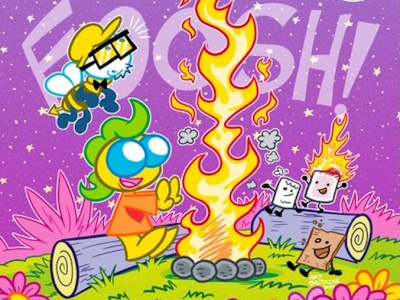Over the last year, DC has announced increasing numbers of sold out periodical comic issues. In Part 1 of our two-part interview, we talked to DC Vice President-Direct Sales Bob Wayne about the sell-out trends and why they're happening.
We went through your e-mail announcements and gathered the number of periodical comic sellouts you reported, and have some questions on that. As a general question, is DC selling out of more titles than it did this time last year?
Yes.
If you look at your inventory on a weekly basis, do you have a higher or lower percentage left over after the initial ship than you did a year ago?
I don't have a pattern that's across the board on a higher or lower percentage, and on some titles I've adjusted how many copies I'm going to have left after a week or two weeks. So there's not a hard and fast rule that I'm operating under on this.
On a percentage basis, are your overages up, down, or stable compared to a year ago?
My overages are up compared to a year ago. As far as the number of copies I have available above the initial order quantities that come in, I'm doing more.
I'm still looking for the leftovers after the first week of shipping. As of when your books ship, Friday or Monday, do you have a larger or a smaller percentage of the initial run left over as compared to a year ago. What I'm trying to get at is whether your sell-outs are an overall trend, or are just on a few titles that are more visible?
It looks like it's an overall trend as far as the line average. We're certainly running a little bit lighter than we were a year ago, in part because some titles are moving substantially larger quantities in reorders than we would have had a year ago, or they're new titles that don't have a year to year comparison. At the same time, there are some titles where I've had 1,000 copies left over for several months in a row, and I don't see any problem in making it where I'm 500 copies closer, and have only 500 copies left to buffer me if it's something where it's a title that's established a very consistent pattern. Primarily that would be on the all ages-oriented stuff that is not really designed for the direct market, like a Scooby Doo or something like that. I've cut back on my overages on those in order to feel more flexible for increasing the overages on the other titles.
So you've changed the mix but overall you're printing a higher percentage of extras and having a smaller percentage left over?
Yes.
The next question relates to how you communicate on this issue, and I guess it also relates to the underlying policies. For some publishers, it's not news when they sell out. For DC, you do communicate when you sell out of periodical books. In your case, why is it news?
Well, we think it's news for a number of reasons. We think that it gives retailers information that the book is selling stronger than we expected, and that perhaps they may well want to look at what the demand is in their own environment and see if they need to increase their orders on the title. We also feel that there are consumers that feel a strong comfort level that a DC book is going to be available on any particular day that they choose to go into a well-stocked store. We want to let those consumers know that they if they're interested in that title, that they may need to start looking for it sooner rather than later because we want to try to meet all the demand that is out there for those particular books.
It was the latter area I was kind of going after. What is your general policy--how many weeks or months after the initial ship date do you want to have a periodical available?
Our goal is to have copies available for reorder for four to six weeks after the book goes on sale.
Has that changed at all in the last year or two?
No, I think we've been relatively consistent with that. Since we began working with Diamond as our sales agent we wanted to have that level of reorder availability. I get a six week report each week of all the titles that have reached that aging period and I take a look at that, and at that point I can decide if I want to hold that inventory at Diamond or if we want to put it on our liquidation 'last chance' sales that we run generally every other week through the Diamond publications. Retailers can buy up our remaining inventory at a reduced price if they're interested, and then after that we either use them ourselves for sampling at conventions or we recycle them.
Do you think that retailer behavior has changed over the last year or two on DCs? Do you think retailers are ordering tighter?
I think retailers were ordering tighter until the last couple of months on a lot of our titles. I think that has begun to shift rather dramatically in some cases. I don't think, however, that a lot of retailers have caught up with what the demand is, what the top is in their own stores on some of the titles. So we're continuing to have some books that are selling out even when the orders have been higher than they were for the previous issues. We definitely have a number of books where we're kind of breaking the curve, where the orders for #3 are higher than the orders for #2, and we had one series where the orders for #3 were higher than the orders for #1.
What was that?
That was Formerly Known as the Justice League, a series that seems to have caught a lot of folks by surprise. You know, reuniting the 1980s Justice League team and creative folks, and it's just blasting out as a mini series. We also had the second issue of Superman/Batman: Trinity by Matt Wagner. The second issue now has higher sales than the first issue because I actually printed more copies of #2 upon seeing how well #1 had done and how quickly it sold out. So we now have higher sales in total on #2 than we had on #1, and we're seeing similar things on Empire, and Teen Titans, and Arrowsmith, and Outsiders, and the long list of books you've been seeing our announcements about.
I want to focus a little bit on this retailer ordering question. You said that up until a few months ago retailers have been ordering tighter, which to me means that a retailer is ordering for a shorter period of sales, or ordering a smaller quantity over reserved copies, or in some other way trying to manage their inventory more tightly or more aggressively. And then you said it shifted the other way in just the last couple of months. Can you talk a little bit about the timing of those changes?
When I say that I think retailers were tighter with their ordering, I mean they were tighter with their ordering on their initial orders, and I think that was because they felt that they had a high level of comfort that DC titles would be available for reorder. So they were being tight on initial orders and counting on us to carry the inventory risk. And I can't fault retailers for starting off with that analysis. I suspect that if I was still in retail I would be doing the same thing. So it's tough for me to be negative about behavior which I'm sure that I would be engaging in along with my former brethren in the retail community.
That probably started when one of the other publishers made a policy shift and turned to no overprints, so people felt that they needed to be more aggressive with initial orders with that publisher because the items wouldn't be available for reorder. And I think that that was a valid judgment call for retailers to make initially. But as things progressed and more and more retailers took that position, it ended up where our initial orders in some cases may well have been so depressed by so many retailers taking a wait and see attitude ('I'll place a reorder later'), that the initial orders on which we base our print runs became distorted and caused some of the sellouts to be really quick.
At the same time we've had a number of titles we've added to our list; we've chopped a bunch of books off that even if they were critically successful, weren't receiving the right level of commercial acceptance in the marketplace. So retailers were also faced with trying to figure out what their order level should be on books that were dramatically different and had a dramatically different level of appeal to the consumer than, in the case of Teen Titans, a book with a very similar title that had only recently gone off the stands. There would be no reason for anyone to necessarily start off and go, 'Gee, I bet I can sell four times the number of copies of this, or five times the number of copies of this.' That's an incredibly large shift in demand for the book. That's why we've tried to keep going back to press on Teen Titans in particular. This morning we just had a meeting of all the sales and marketing people that work in direct sales to the retailers, and apparently the third printing of Teen Titans may well be sold out by the close of business today. It certainly is doing better than even we expected at this point, and we were kind of optimistic.
Are you saying that retailers had a certain amount of risk money and they took that out of DC and some other publishers and stuck it into the publisher that changed its overprint policy so they wouldn't risk selling out?







